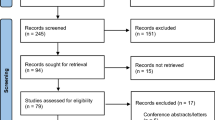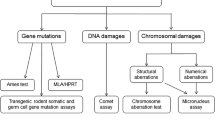Abstract
Objective
Antineoplastic drugs (ADs) are widely used in clinical practice and have been demonstrated to be effective in treating malignant tumors. However, they carry a risk of cytogenotoxicity for healthcare workers. Studies have reported that genotoxic biomarkers can be applied to assess the occupational health status of healthcare workers at an early stage, but results of different studies are variable. The objectives of the review were examine the association between long-term exposure to ADs and cytogenetic damage to healthcare workers.
Methods
We systematically reviewed studies between 2005 and 2021 using PubMed, Embase and Web of Science databases that used cytogenetic biomarkers to assess occupational exposure to ADs in healthcare workers. We used RevMan5.4 to analyze the tail length parameters of the DNA, frequency of the chromosomal aberrations, sister chromatid exchanges and micronuclei. A total of 16 studies were included in our study. The studies evaluate the quality of the literature through the Agency for Healthcare Research and Quality.
Results
The results revealed that under the random-effects model, the estimated standard deviation was 2.37 (95% confidence interval [CI] 0.92–3.81, P = 0.001) for the tail length parameters of the DNA, 1.48 (95% CI 0.71–2.25, P = 0.0002) for the frequency of chromosomal aberrations, 1.74 (95% CI 0.49–2.99, P = 0.006) for the frequency of sister chromatid exchanges and 1.64 (95% CI 0.83–2.45, P < 0.0001) for the frequency of micronuclei.
Conclusions
The results indicate that there is a significant association between occupational exposure to ADs and cytogenetic damage, to which healthcare workers should be alerted.








Similar content being viewed by others
Data availability
Data are available on reasonable request. Data cannot be made publicly available, because public availability would compromise participant privacy.
References
Bi J, Wang R (2018) The comparison of methods on the cytokinesis block micronucleus cell (CB-MNT) detection. Captial J Pub Health 12(02):109–111
Bouraoui S, Brahem A, Tabka F et al (2011a) Assessment of chromosomal aberrations, micronuclei and proliferation rate index in peripheral lymphocytes from Tunisian nurses handling cytotoxic drugs. Environ Toxicol Pharmacol 31(1):250–257
Bray F, Ferlay J, Soerjomataram I et al (2018) Global cancer statistics 2018: GLOBOCAN estimates of incidence and mortality worldwide for 36 cancers in 185 countries. CA Cancer J Clin 68(6):394–424
Burgaz S, Karahalil B, Canhi Z et al (2002) Assessment of genotoxic damage in nurses occupationally exposed to antineoplastics by the analysis of chromosomal aberrations. Hum Exp Toxicol 21(3):129–135
Buschini A, Villarini M, Feretti D et al (2013) Multicentre study for the evaluation of mutagenic/carcinogenic risk in nurses exposed to antineoplastic drugs: assessment of DNA damage. Occup Environ Med 70(11):789–794
Chen W, Angao Xu, Zhang X (2017) Advances in the study of disease burden of malignant tumors. J Med Theory Pract 30(14):2062–2065
Connor TH, Mcdiarmid MA (2006) Preventing occupational exposures to antineoplastic drugs in health care settings. CA Cancer J Clin 56(6):354–365
Connor TH, Debord G, Pretty JR et al (2010) Evaluation of antineoplastic drug exposure of health care workers at three university-based US cancer centers. J Occup Environ Med 52(10):1019–1027
Cornetta T, Padua L, Testa A et al (2008) Molecular biomonitoring of a population of nurses handling antineoplastic drugs. Mutat Res 638(1–2):75–82
El-Ebiary AA, Abuelfadl AA, Sarhan NI (2013) Evaluation of genotoxicity induced by exposure to antineoplastic drugs in lymphocytes of oncology nurses and pharmacists. J Appl Toxicol 33(3):196–201
Fakher HM, Metwally ES, Rabab Sh E-S (2021) The potential genotoxic effects of antineoplastic drugs in occupationally exposed nurses. Asia Pacific J Med Toxicol 10(1):60–66
Goloni-Bertollo EM, Tajara EH, Manzato AJ et al (1992) Sister chromatid exchanges and chromosome aberrations in lymphocytes of nurses handling antineoplastic drugs. Int J Cancer 50(3):341–344
Huang X, Gao C, Cai W et al (2021a) Effect of occupational exposure to antineoplastic drugs on DNA damage in nurses: a cross-sectional study. Occup Environ Med. https://doi.org/10.1136/oemed-2021-107913
Huang C, Niu X, Gao C et al (2021b) Micronucleus analysis of peripheral blood lymphocytes in nurses with occupational exposure to antineoplastic drugs. Occup Health 37(04):458–462
Kopjar N, Kasuba V, Rozgaj R et al (2009) The genotoxic risk in health care workers occupationally exposed to cytotoxic drugs–a comprehensive evaluation by the SCE assay. J Environ Sci Health A Tox Hazard Subst Environ Eng 44(5):462–479
Ladeira C, Viegas S, Pádua M et al (2014) Assessment of genotoxic effects in nurses handling cytostatic drugs. J Toxicol Environ Health Part A Curr Issues 77(14–16):879–887
Laffon B, Teixeira JP, Silva S et al (2005) Genotoxic effects in a population of nurses handling antineoplastic drugs, and relationship with genetic polymorphisms in DNA repair enzymes. Am J Ind Med 48(2):128–136
Li L (2017) Risk assessment of health effect on nurse occupationally exposed to antineoplastic drugs in shenzhen hospital. Zunyi Medical University, Zunyi
Mahmoodi M, Soleyman-Jahi S, Zendehdel K et al (2017) Chromosomal aberrations, sister chromatid exchanges, and micronuclei in lymphocytes of oncology department personnel handling anti-neoplastic drugs. Drug Chem Toxicol 40(2):235–240
Moola S, Munn Z, Tufanaru C, Aromataris E, Sears K, Sfetcu R, Currie M, Lisy K, Qureshi R, Mattis P, Mu P (2020) Chapter 7: Systematic reviews of etiology and risk. In: Aromataris E, Munn Z (eds) JBI manual for evidence synthesis. JBI. https://synthesismanual.jbi.global. https://doi.org/10.46658/JBIMES-20-08
Moretti M, Grollino MG, Pavanello S et al (2015) Micronuclei and chromosome aberrations in subjects occupationally exposed to antineoplastic drugs: a multicentric approach. Int Arch Occup Environ Health 88(6):683–695
Rekhadevi PV, Sailaja N, Chandrasekhar M et al (2007) Genotoxicity assessment in oncology nurses handling anti-neoplastic drugs. Mutagenesis 22(6):395–401
Roussel C, Witt KL, Shaw PB et al (2019) Meta-analysis of chromosomal aberrations as a biomarker of exposure in healthcare workers occupationally exposed to antineoplastic drugs. Mutat Res Rev Mutat Res 781:207–217
Santovito A, Cervella P, Delpero M (2014) Chromosomal damage in peripheral blood lymphocytes from nurses occupationally exposed to chemicals. Hum Exp Toxicol 33(9):897–903
Sasaki M, Dakeishi M, Hoshi S et al (2008) Assessment of DNA damage in Japanese nurses handling antineoplastic drugs by the comet assay. J Occup Health 50(1):7–12
Shen X, Chen Y, Wen Z et al (2021) Research progress of automated micronucleus analysis technology for cytokinesis arrest. J Radiat Res Radiat 39(03):3–10
Siegel RL, Miller KD, Jemal A (2020) Cancer statistics. CA Cancer J Clin 70(1):7–30
Suspiro A, Prista J (2011) Biomarkers of occupational exposure do anticancer agents: a minireview. Toxicol Lett 207(1):42–52
Testa A, Giachelia M, Palma S et al (2007) Occupational exposure to antineoplastic agents induces a high level of chromosome damage. Lack of an effect of GST polymorphisms. Toxicol Appl Pharmacol 223(1):46–55
Ursini CL, Cavallo D, Colombi A et al (2006) Evaluation of early DNA damage in healthcare workers handling antineoplastic drugs. Int Arch Occup Environ Health 80(2):134–140
Villarini M, Dominici L, Fatigoni C et al (2012) Biological effect monitoring in peripheral blood lymphocytes from subjects occupationally exposed to antineoplastic drugs: assessment of micronuclei frequency. J Occup Health 54(6):405–415
Xiao H (2019) Hazards of chemotherapy drugs to oncology nurses and occupational protection. Chin Commun Dr 35(28):130–132
You Li, Fan Y, Liu Q et al (2010) Study on genetic damage in workers exposed to benzene. Chin J Ind Med 23(03):170–172
Zare Sakhvidi MJ, Hajaghazadeh M, Mostaghaci M et al (2016) Applicability of the comet assay in evaluation of DNA damage in healthcare providers’ working with antineoplastic drugs: a systematic review and meta-analysis. Int J Occup Environ Health 22(1):52–67
Zheng Ke, Pan J, Jiang Z et al (2002) The principle of sister chromatid exchange(SCE) detection and its molecular mechanism. Chin J Cell Biol 06:355–359
Acknowledgements
We thank Drs.XiaoHong Huang and Yeqing Gu for providing a careful review of the manuscript and helpful comments.
Funding
This work was supported by the special fund for the association between exposure to antineoplastic agents and genotoxicity of female healthcare workers [LGWJ2021-14].
Author information
Authors and Affiliations
Contributions
HH, YG and XH contributed to the study conception and design; HH, YG, SL, SH, XZ, YH and JP contributed to data collection, assembly, analysis and interpretation of the data; HH, YG and XH contributed to the manuscript drafting and revising. All authors approved the final version of the manuscript. HH was responsible for the overall content as guarantor.
Corresponding author
Ethics declarations
Conflict of interest
The authors have nothing to disclose.
Additional information
Publisher's Note
Springer Nature remains neutral with regard to jurisdictional claims in published maps and institutional affiliations.
Supplementary Information
Below is the link to the electronic supplementary material.
Rights and permissions
Springer Nature or its licensor (e.g. a society or other partner) holds exclusive rights to this article under a publishing agreement with the author(s) or other rightsholder(s); author self-archiving of the accepted manuscript version of this article is solely governed by the terms of such publishing agreement and applicable law.
About this article
Cite this article
Huang, H., Gu, Y., Liu, S. et al. The meta-analysis of cytogenetic biomarkers as an assessment of occupational risk for healthcare workers exposed to antineoplastic drugs. Int Arch Occup Environ Health 96, 785–796 (2023). https://doi.org/10.1007/s00420-023-01969-6
Received:
Accepted:
Published:
Issue Date:
DOI: https://doi.org/10.1007/s00420-023-01969-6




